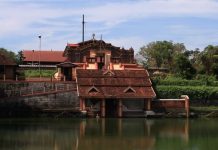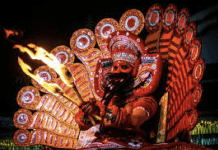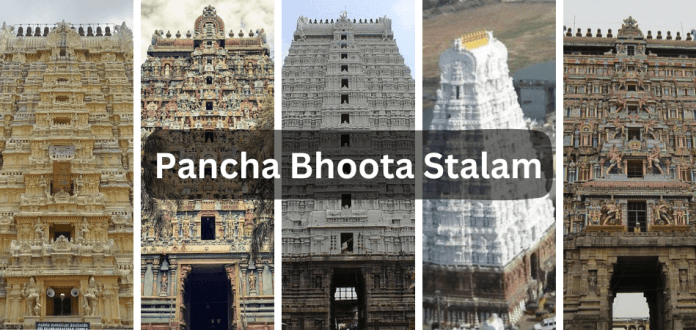Pancha Bhoota Stalam, also known as Pancha Bhoota Temple, refers to a group of five Lord Shiva temples that represent the five prime elements of nature. These temples are located in South India, with four in Tamil Nadu and one in Andhra Pradesh. The term “Pancha” means “five,” “Bhoota” means “elements,” and “Stalam” means “place.” Each temple is associated with one of the five elements: earth, water, fire, air, and ether.
The term “Pancha Bhoota”
The term “Pancha Bhoota” refers to the five fundamental elements of nature mentioned in the Vedas: earth (Prithvi), water (Jala), fire (Agni), air (Vayu), and ether/space (Akash). These elements are believed to be enshrined in the form of lingams (symbolic representations of Lord Shiva) in the respective temples. The elements are deeply integrated into various aspects of Indian culture, including Ayurveda, where the balance of the body is connected to the equilibrium of the Pancha Bhoota.
The Pancha Bhoota Temples
The Pancha Bhoota temples are strategically positioned around the 78°E and 79°E longitudes, as well as between 10°N and 14°N latitudes. Each temple enshrines a lingam, symbolizing the element it represents, and is named accordingly.
The four temples in Tamil Nadu are maintained and administered by the Hindu Religious and Charitable Endowments Department of the Government of Tamil Nadu. They are also considered Paadal Petra Sthalam, meaning they are revered in the Tevaram, a 7th-century Tamil Saiva canonical work composed by the Nayanars, the Tamil saint poets.
1. Ekambareswarar Temple (Earth Element):
Located in Kanchipuram, Tamil Nadu, this temple represents the earth element. The presiding deity is Ekambareswarar (Lord Shiva), worshipped in the form of Prithvi Lingam, symbolizing the element of earth. Ekambareswarar Temple, situated at approximately 12.847217 °N latitude and 79.700272 °E longitude.
2. Jambukeswarar Temple (Water Element):
Situated in Thiruvanaikaval near Trichy, Tamil Nadu, this temple represents the water element (Jala). The temple is dedicated to Lord Jambukeswarar, worshipped as the Water Lingam. The temple houses a sacred water tank called “Siddha Kund,” adding to the sanctity and significance of the water element. Jambukeswarar Temple, located at around 10.8270°N latitude and 78.7051°E longitude.
3. Arunachalesvara Temple or Annamalaiyar Temple, Thiruvannamalai (Fire Element):
Located in Tiruvannamalai, Tamil Nadu, this temple represents the fire element (Agni). The presiding deity is Lord Arunachalesvara (Lord Shiva) or Annamalaiyar, worshipped as the Fire Lingam. The temple is situated at the foot of the sacred Arunachala Hill, radiates the fiery energy and transformative power associated with the element of fire. The temple is situated at approximately 12.2300°N latitude and 79.0702°E longitude.
4. Kalahasti Temple (Air Element):
Situated in Srikalahasti, Andhra Pradesh, this temple represents the air element. Lord Kalahasteeswara is the presiding deity, worshipped as the Air Lingam. The temple is famous for its Vayu Lingam, and according to legends, it is associated with the tale of a spider saving Lord Shiva from a snake bite. Devotees seek blessings for clarity, freedom, and the flow of vital energy. The temple is situated at approximately 13°44′58″N latitude and 79°41′54″E longitude.
5. Thillai Nataraja Temple, Chidambaram (Space Element):
Located in Chidambaram, Tamil Nadu, the Thillai Nataraja Temple represents the space element. Lord Nataraja, the cosmic form of Lord Shiva, is worshipped as the Space Lingam. The temple is renowned for its intricate carvings and the unique cosmic dance pose of Lord Nataraja, representing the cosmic rhythms and the vast expanse of space. The temple is situated at approximately 11°23′58″N latitude and 79°41′36″E longitude.
These Pancha Bhoota Temples hold deep spiritual significance and attract devotees seeking blessings, spiritual experiences, and a connection with the elements of nature. Each temple showcases unique architectural marvels and ancient traditions, making them important pilgrimage sites in South India.























































